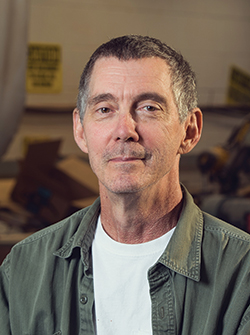
From unpacking art to painting walls and guiding exhibition design, the Gilcrease Museum prep team is behind the scenes making it all happen. We sat down with Chief Preparator Curt Selby to learn more.
Q: Where are you from?
A: I grew up in Decatur, Illinois (go Cubs!).
Q: How long have you worked at Gilcrease and in what roles?
A: I have been at Gilcrease for almost six years. I started as a preparator and recently became the chief preparator in January of this year.
Q: What does the prep team at Gilcrease do?
A: We take care of all aspects of exhibition installation, and I mean everything — From unloading/loading trucks to unpacking art, assisting with layout and spacing, hanging art on the wall, lighting the artwork, creating exhibition graphics and text production, preparing pedestals for 3D and artifact objects and designing and fabrication of additional exhibition furniture: We do it all.
Q: Who is on the prep team, and do you each have specific roles?
A: In no particular order, prep team members are Patrick Geary, our exhibition designer; Jeff Brierly, our exhibition technician; Kelly Campbell, a preparator and me. Between the four of us, we have a broad range of overlapping skills, but also individual strengths. Patrick’s greatest strength his is strong artistic and esthetic sense, while Kelly is a master carpenter and mount maker and takes the lead on exhibition lighting. Jeff is our 3D specialist, with many years of experience working with bronze and stone sculpture.
Q: What is the most challenging part of installing a new exhibition?
A: Making sure the art is protected at all times.
Q: Walk us through the planning process of installing a traveling exhibition.
A: With a traveling exhibit, six to 12 months in advance we receive an “object list” and Patrick begins to figure how best to fit the exhibition into one of our galleries. Next, we quickly determine any casework and pedestal needs. Then, once a gallery is empty from a previous exhibition, we all begin painting, if necessary, and take care of in-house graphics, text panels, ID labels, wall clings, etc. When the art is finally delivered, we unload the trucks. The final process is laying out the exhibition, hanging the art, installing the casework/pedestals, fine-tuning the lighting and applying graphics.